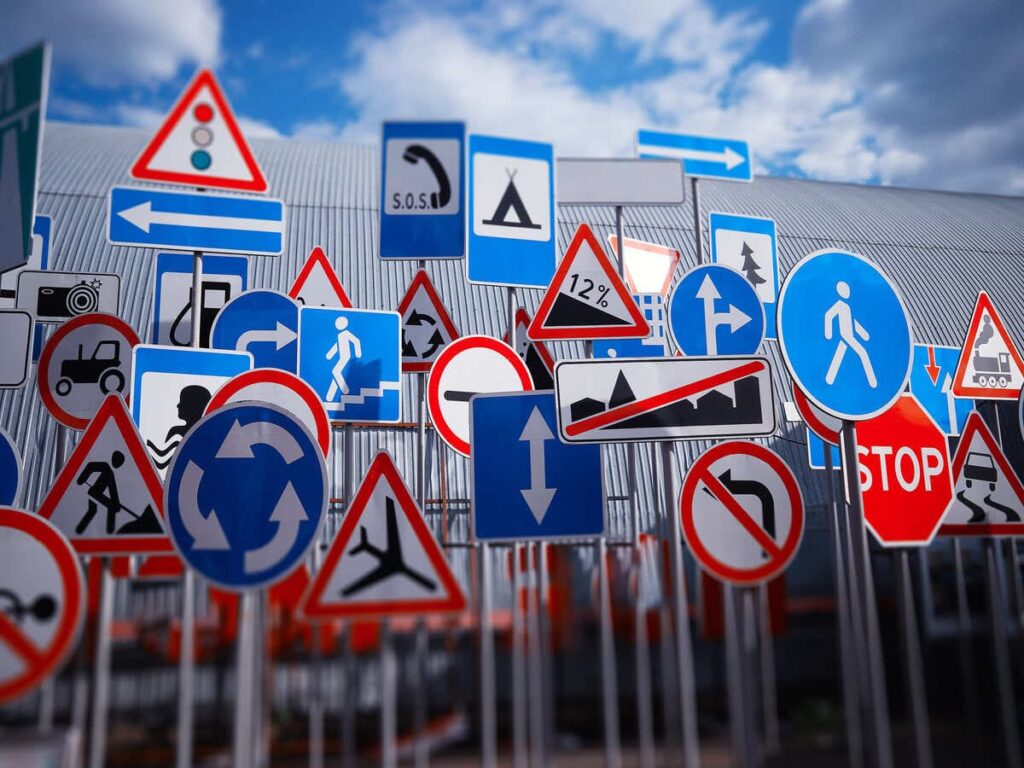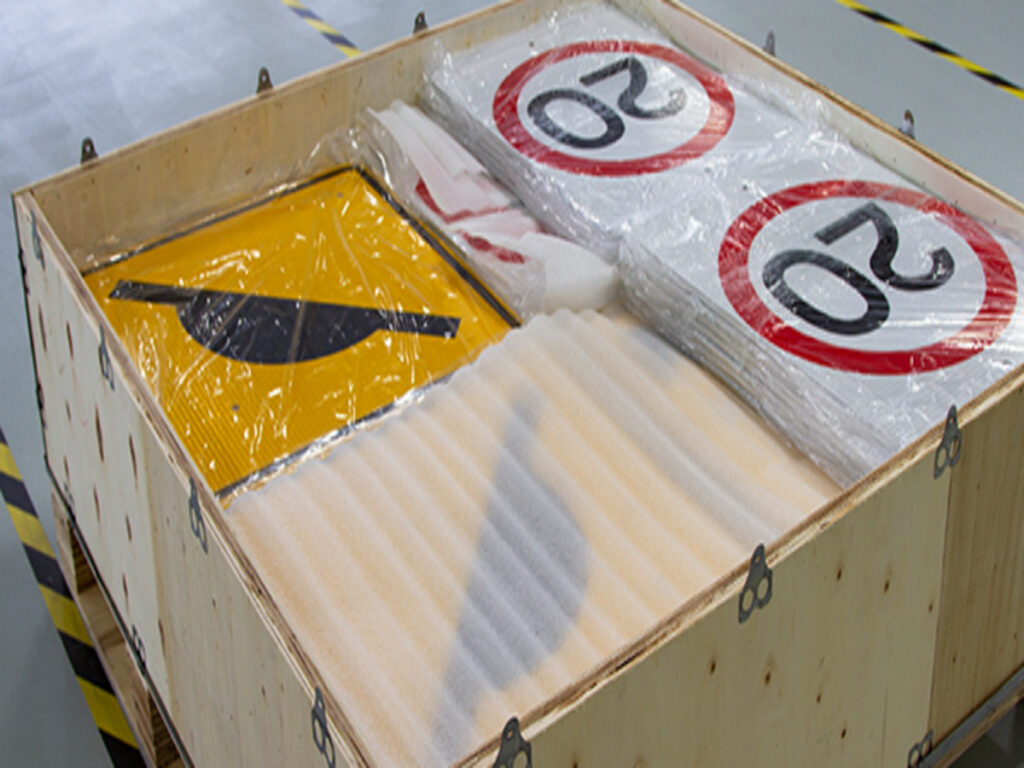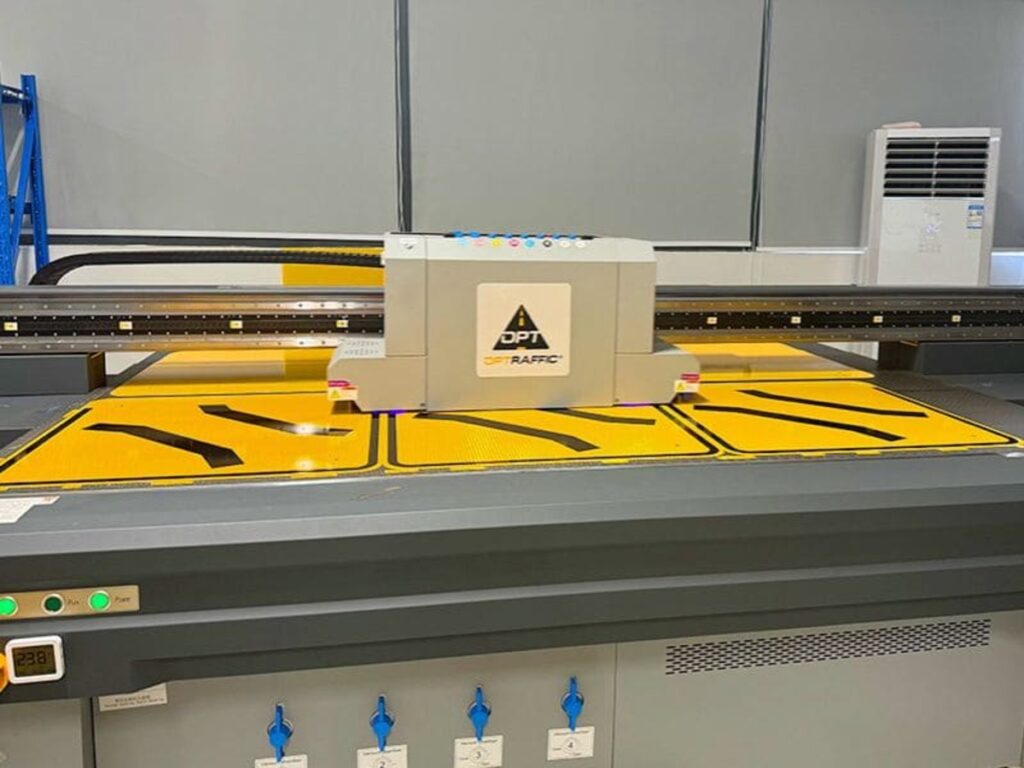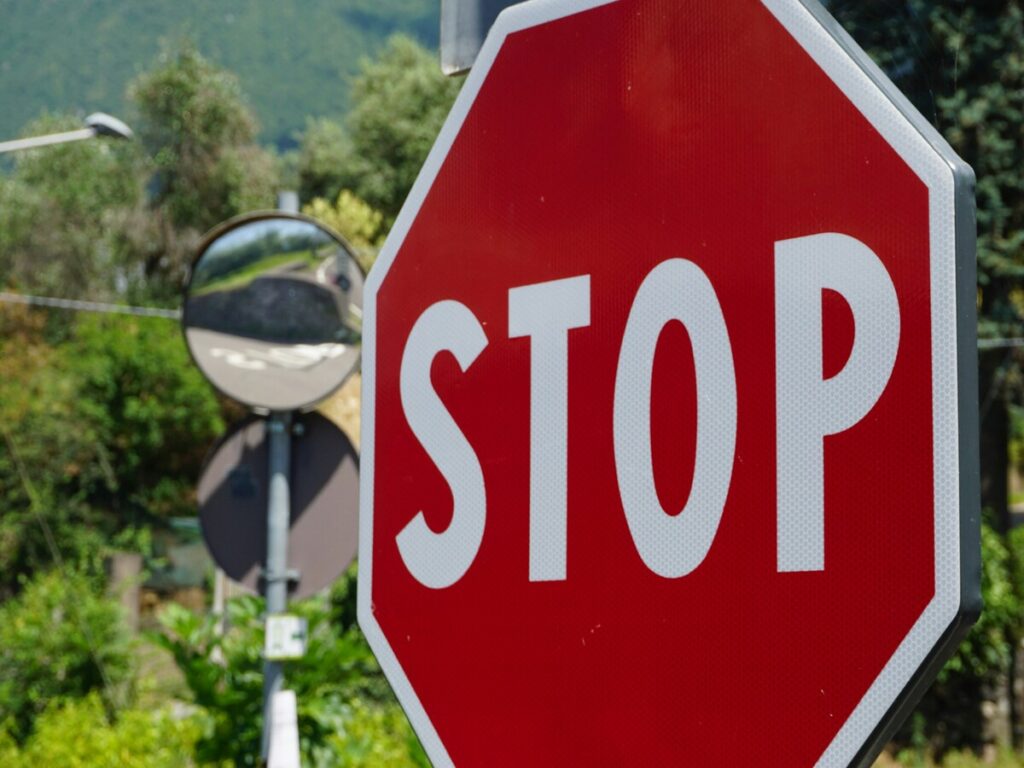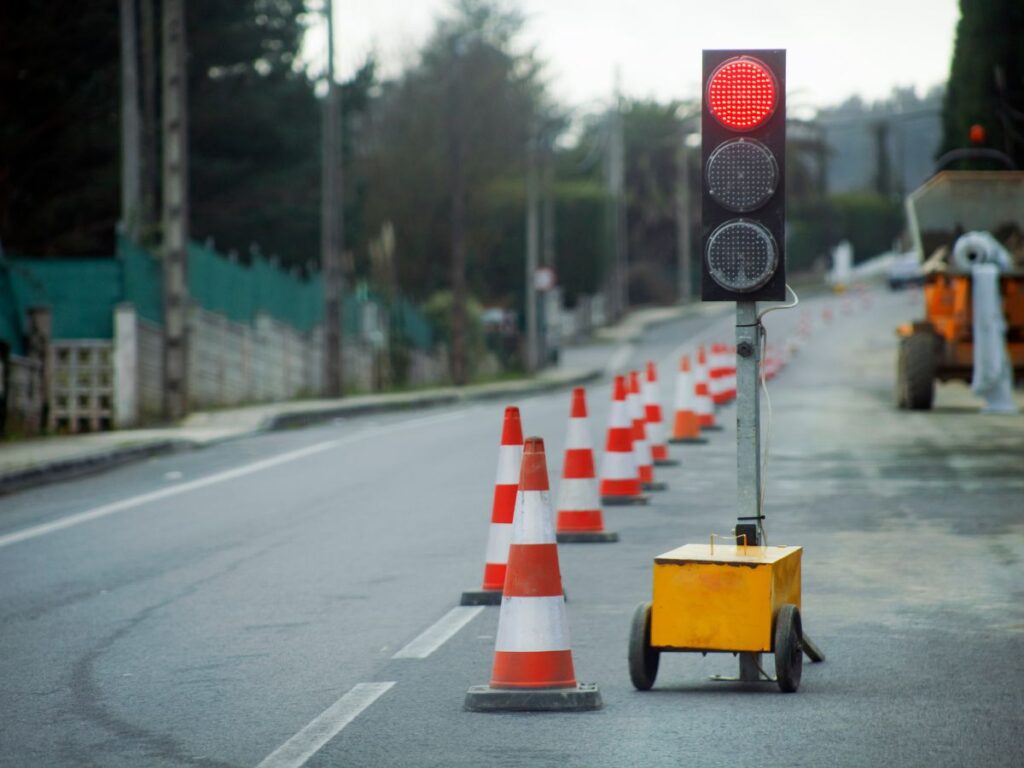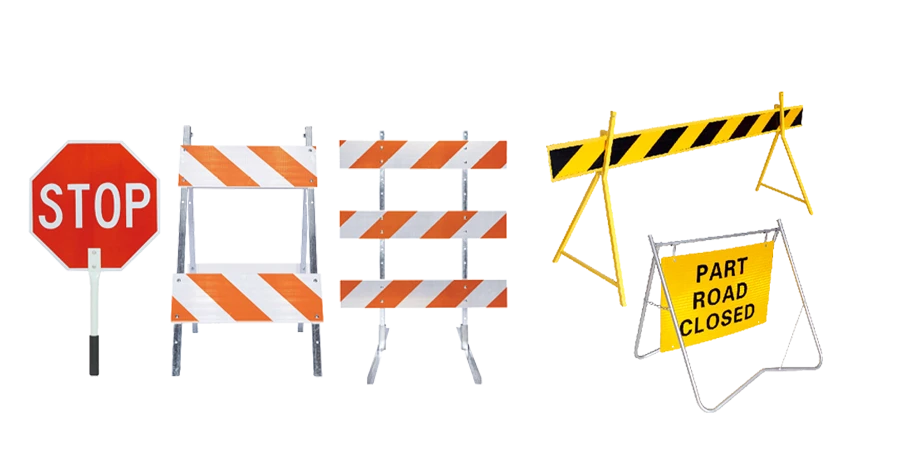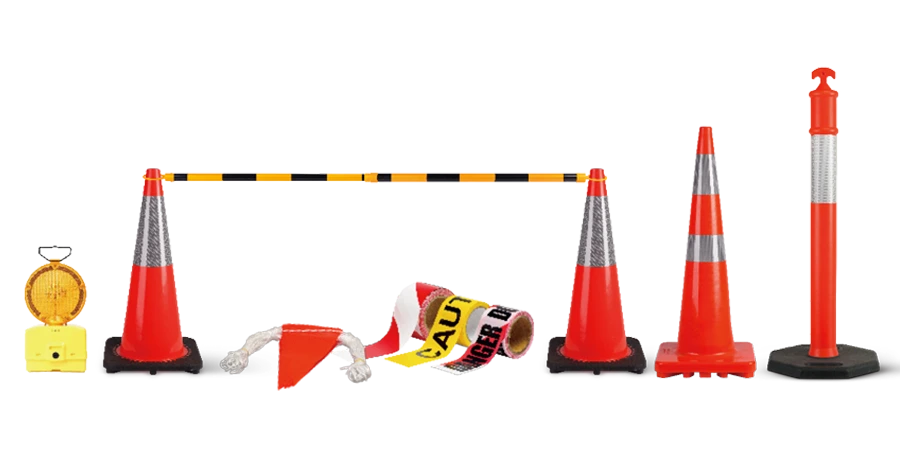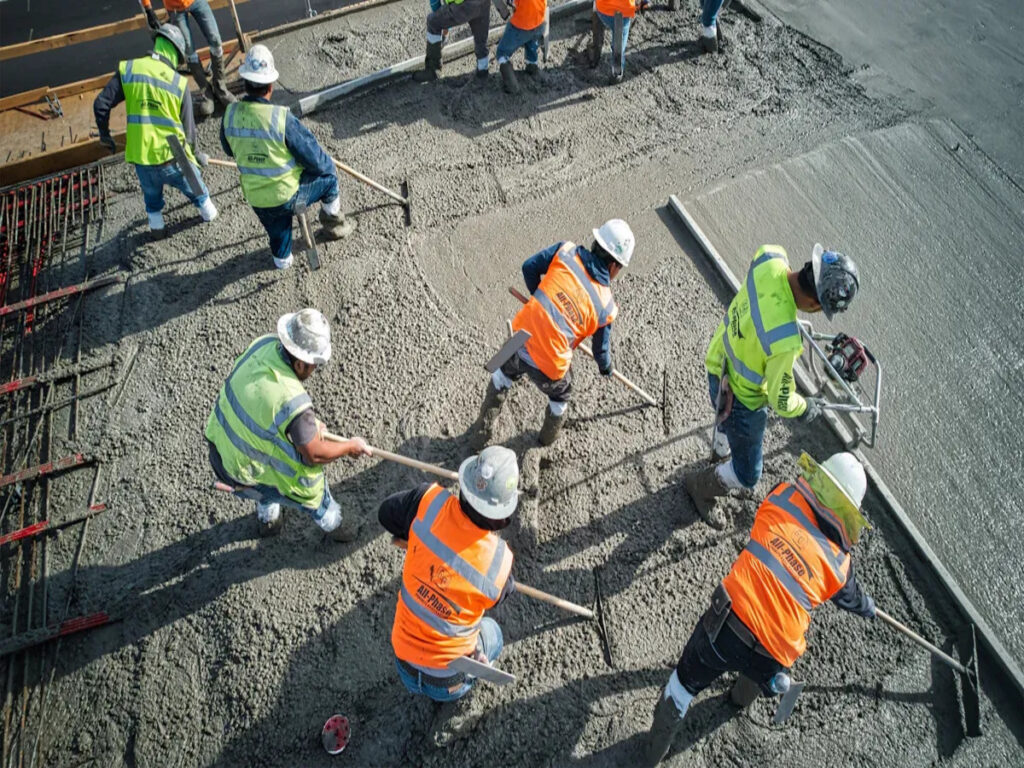
4 월은 더 많은 야외 건설 작업을 제공합니다, 안전이 핵심입니다. 이번 시즌에는 봄 날씨와 바쁜 도로 변화와 같은 도전이 있습니다.. 이러한 문제는 근로자를 안전하게 유지하고 일자리가 원활하게 운영되도록 신중한 계획이 필요합니다..
위험은 심각합니다. 도로 근로자는 부상과 사망률이 높습니다. 직장 부상은 비용이 초과되었습니다 $170 매년 10 억. 치명적이지 않은 낙상은 혼자 비용입니다 $2.5 매년 10 억. 안전에 중점을두고 교통 안전 제품을 사용하여, 이 바쁜 시간 동안 위험을 낮추고 더 잘 일할 수 있습니다..
광교통 근로자를 보호하고 건설 현장에서 안전을 향상시키기 위해 설계된 고품질 교통 안전 제품을 제공합니다.. 원뿔 및 장벽에서 반사 징후 및 안전 장비까지, 안전한 작업 환경을 보장하는 데 필요한 도구를 제공합니다..
당사의 제품에 대해 자세히 알아 보려면 오늘 저희에게 연락하여 안전하고 준수하는 방법에 대해 자세히 알아보십시오..
건설 현장 안전을 위해 봄 날씨에 적응
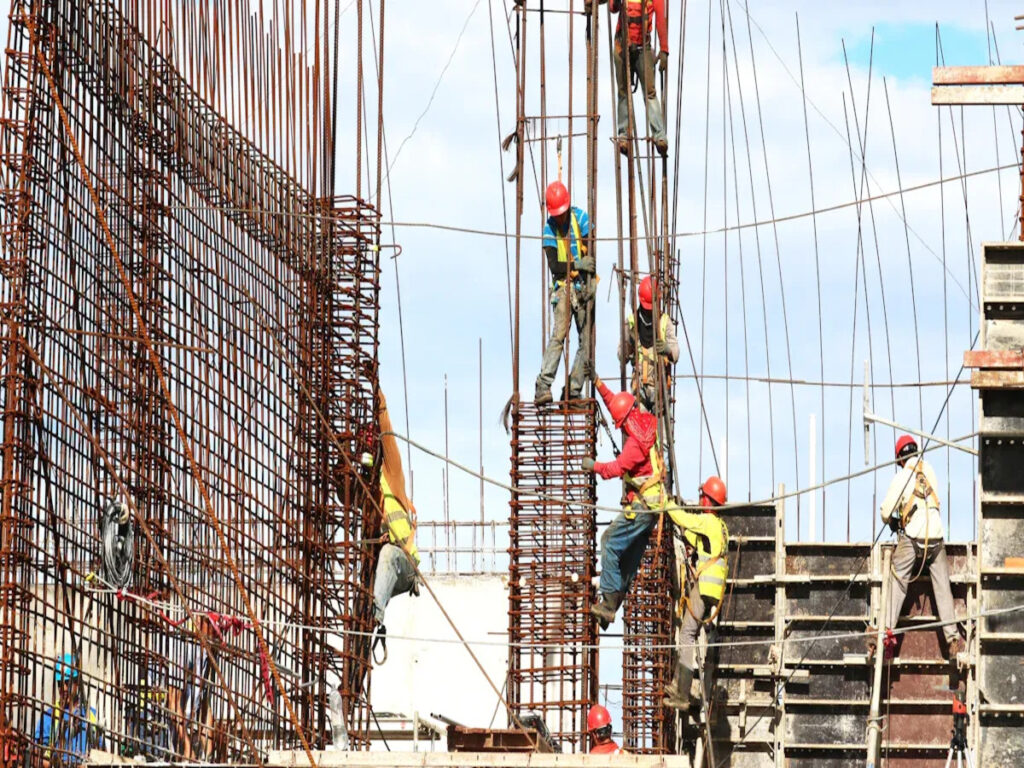
봄 날씨의 도전
봄 날씨는 건설 작업을 더욱 어렵게 만들 수 있습니다. 비, 변화하는 온도, 폭풍은 일을 지연시키고 위험을 유발할 수 있습니다. 계절 날씨는 홍수와 강한 폭풍을 가져올 수 있습니다, 더 많은 사고로 이어집니다. 이러한 위험은 봄과 여름에 더 높습니다, 따라서 경고를 유지하는 것은 안전에 중요합니다.
악천후는 도구와 재료에 해를 끼칠 수 있습니다. 비는 일부 재료를 약화시킬 수 있습니다, 추운 날씨는 느리게 작동 할 수 있습니다. 날씨 보고서 확인 및 미리 계획하면 이러한 문제를 처리하는 데 도움이됩니다..
날씨에 맞는 보호 장비
봄에는 올바른 장비를 착용하는 것이 매우 중요합니다. 비옷, 방수 부츠, 그리고 장갑은 근로자가 건조하고 안전하게 지내도록 도와줍니다. 근로자가 다른 사람들에게 보이도록 흐리거나 비오는 날에 밝은 조끼가 필요합니다..
계층화 할 수있는 옷도 도움이됩니다. 근로자는 층을 추가하거나 제거하여 날씨 변화에 편안하게 유지할 수 있습니다.. 이것은 과열 또는 너무 추워지는 것을 방지합니다. 근로자에게 적절한 장비를 제공하면 안전하게 유지하고 더 나은 일을하도록 도와줍니다..
습하고 미끄러운 조건에 대한 현장 안전 조치
비는 건축 현장을 미끄럽고 위험하게 만듭니다. 웅덩이와 진흙은 사람들이 미끄러지고 넘어 질 수 있습니다.. 이 사고는 봄에 더 자주 발생합니다, 따라서 추가 안전 단계가 필요합니다.
사이트를 더 안전하게 만들기 위해 몇 가지 작업을 수행 할 수 있습니다.:
- 물이 쌓이는 것을 막기 위해 배수구를 추가하십시오.
- 보도에 미끄럼 방지 코팅을 사용하십시오.
- 웅덩이와 진흙을 제거하기 위해 영역을 확인하고 청소하십시오.
노동자들이 미끄러운 반점을 발견하고 피하도록 훈련시킵니다. 젖은 지역에 대해 경고하기 위해 안전 징후를 제시하십시오. 이러한 행동은 위험을 낮추고 모든 사람을 위해 사이트를 더 안전하게 만듭니다..
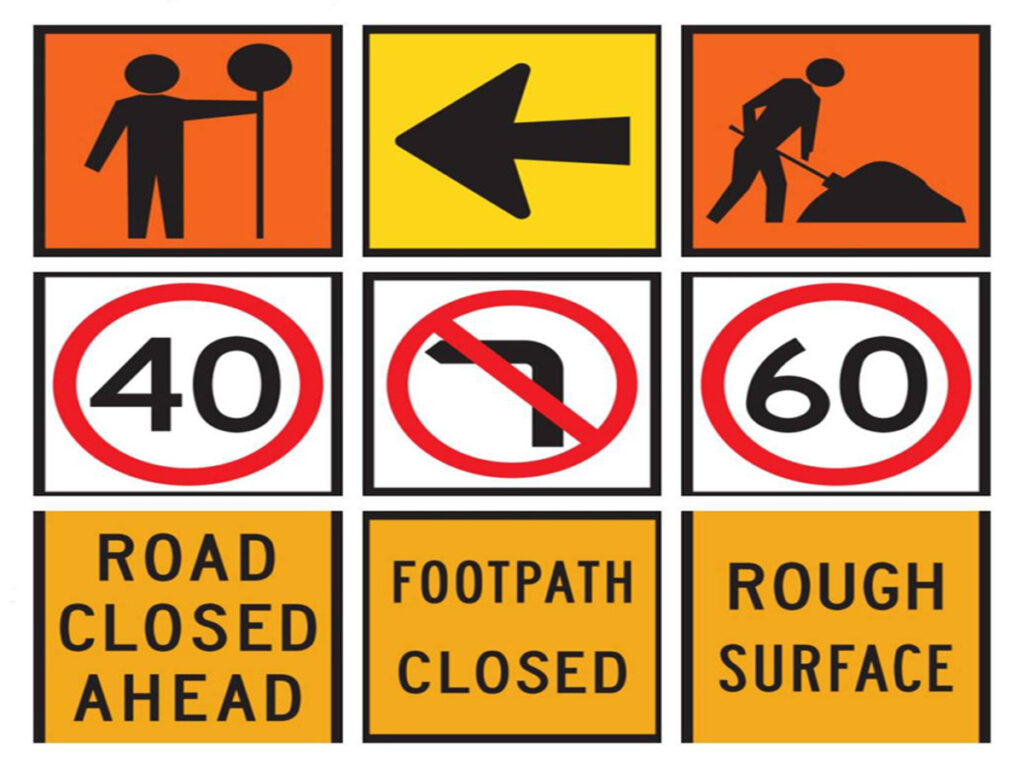
Optraffic은 광범위한 안전 표시를 제공합니다. 안전한 건축 환경을 유지하는 데 도움이됩니다. 습식 경고에서 위험 식별까지, 우리의 고품질 안전 징후는 근로자가 잠재적 인 위험을 인식 할 수 있도록합니다..
건설 현장에 대한 올바른 안전 표시를 보장하려면 오늘 저희에게 연락하십시오.!
내후성 재료 사용
봄 날씨는 비와 함께 빠르게 변할 수 있습니다, 폭풍, 온도 이동. 선발 내후성 재료 건축 프로젝트를 위해서는 강력하고 안전하게 유지합니다. 이 재료는 악천후로 인한 손상 및 지연으로부터 구조를 보호합니다..
다음은 날씨 변화에 잘 작동하는 몇 가지 재료입니다.:
- 콘크리트: 매우 강하고 폭우와 바람을 처리합니다.. 건물의 기초와 주요 부분에 좋은 선택입니다..
- 강철: 강철은 썩거나 구부리지 않습니다. 날씨가 딱딱 해져도 강하게 유지됩니다.
- 벽돌: 벽돌은 건물을 따뜻하거나 시원하게 유지합니다. 봄의 온도 변화에 도움이됩니다.
지붕은 건설 현장을 보호 하는데도 중요하다. 오른쪽 지붕을 사용하여 올바르게 설치하면 더 오래 지속됩니다.. 폭풍과 온도 변화를 위해 제작 된 지붕은 수리가 적습니다..
선택 내후성 재료 수리 비용을 낮추고 안전을 향상시킵니다. 예를 들어, 콘크리트 그리고 강철 폭풍 동안 건물이 부러지는 것을 방지하십시오. 벽돌 그리고 좋은 지붕은 실내 공간을 편안하게 유지합니다, 외부의 날씨가 나쁘더라도.
이러한 자료를 프로젝트에 추가하면 더 오래 지속되고 추적됩니다.. 손상된 재료 나 날씨 문제의 지연을 피합니다. 미리 계획하고 올바른 재료를 사용하는 것은 Spring의 과제를 처리하는 현명한 방법입니다..
광교통 UV 저항력이 있고 비바람에 견디는 고품질 교통 안전 제품을 제공합니다., 옥외 사용을 위해 완벽한. 삼투래의 내구성이 뛰어난 제품은 안전과 성능을 보장합니다, 기상 조건에 관계없이.
교통 안전 제품 및 도로 건설 안전
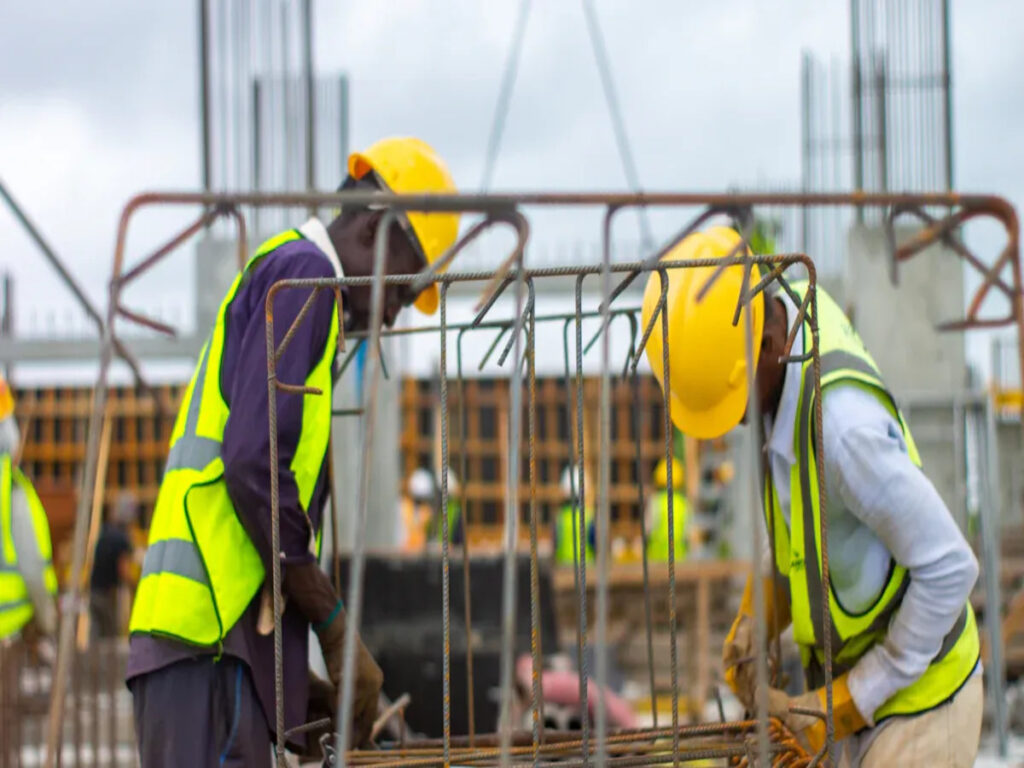
봄에 더 많은 트래픽을 처리합니다
봄은 도로에서 더 많은 차를 의미합니다. 이로 인해 도로 작업이 더 어려워집니다. 근로자가 안전하고 트래픽 이동을 유지하려면 계획이 필요합니다.. 다시 라우팅 된 트래픽은 도로를 더 빨리 마모 할 수 있습니다, 수리 비용 증가. 아래 표는 트래픽을 더 잘 관리하는 방법을 보여줍니다:
| 문제 | 해결책 |
|---|---|
| 트래픽 손상 도로의 재방송 | 우회로의 대형 트럭은 도로를 더 빨리 마모합니다. |
| 교통량이 많은 경우 수리 비용이 더 많이 듭니다 | 더 많은 트럭은 더 빈번한 도로 고정을 의미합니다. |
| 긴 폐쇄는 도로 손상을 증가시킵니다 | 우회가 길어 대체 노선에서 수리 요구가 더 높아집니다.. |
이러한 문제를 아는 것은 더 나은 계획에 도움이됩니다. 이것은 도로 손상을 줄이고 근로자를 안전하게 유지합니다.
도로 작업 안전을위한 중요한 도구
교통 안전 제품은 안전한 도로 작업의 핵심입니다. 그들은 자동차를 안내하고 노동자를 보호합니다. 도로 원뿔과 같은 교통 안전 제품, 도로 장벽, 마커는 운전자를 위해 영역을 명확하게 만듭니다. 연구에 따르면 이러한 교통 안전 제품은 안전 및 작업 속도를 향상시킵니다.. 아래 표는 그들의 이점을 보여줍니다:
| 혜택 | 결과 |
|---|---|
| 자동차 노동자 충돌이 적습니다 | 35% 텍사스 프로젝트를 떨어 뜨립니다 |
| 적은 부상 | 25% 캘리포니아 프로젝트를 중단하십시오 |
| 더 적은 사고 | 50% 더 안전한 구역이 적습니다 |
| 더 빠른 작업 | 20% 오하이오 프로젝트에서 더 빠릅니다 |
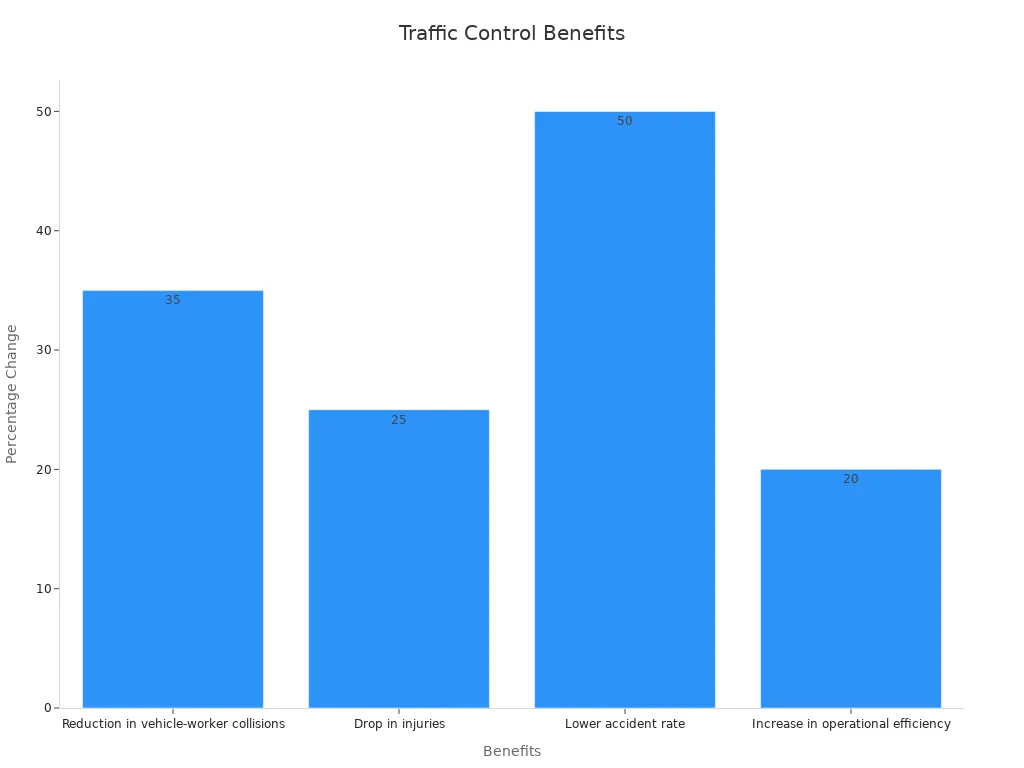
이 교통 안전 제품은 구역을 더 안전하게 만들고 일을 더 빨리 도와줍니다..
실시간 트래픽 정보에 대한 표시
메시지가 변경된 표지판 (VMS) 매우 도움이됩니다. 트래픽에 대한 업데이트를 제공합니다, 충돌, 그리고 우회. 운전자는이 정보로 더 나은 선택을 할 수 있습니다. 도시에서, VMS는 지연을 많이 삭감했습니다. 예를 들어:
- VMS는 트래픽 감소를 우회합니다 2% 에게 30% 사우 샘프 턴에서.
- 새로운 VMS 기술은 여행 시간을 줄입니다 32% 보고타에서.
VMS를 사용하면 트래픽 흐름과 안전이 향상됩니다. 이 표지판은 자동차가 작업 구역을 더 잘 이동하고 모든 사람을 더 안전하게 유지하는 데 도움이됩니다..
Optraffic은 판매용 고품질 VM을 제공합니다 (가변 메시지 부호) 해당 지역의 트래픽 관리를 개선합니다. Optraffic Advanced VMS 솔루션은 실시간 업데이트를 제공합니다, 작업 영역의 지연을 줄이고 안전을 향상시키는 데 도움.
보행자를 장벽과 안전 징후로 안전하게 유지합니다
바쁜 건축 지역에서 보행자를 안전하게 유지하는 것은 매우 중요합니다.. 위험으로부터 사람들을 보호하기 위해 조치를 취해야합니다.. 장벽과 명확한 표시는 모든 사람에게 지역을 더 안전하게 만드는 데 도움이 될 수 있습니다..
장벽은 방패처럼 작동합니다, 사람들을 안전하지 않은 곳에서 멀리 유지하십시오. 그들은 보행자가 안전한 길을 안내하고 위험한 구역을 차단합니다.. 예를 들어, 기계 나 열린 구멍 근처에 장벽을두면 부상 위험이 줄어 듭니다.. 이러한 장벽을 자주 확인하여 강하고 유용한 상태를 유지하십시오..
표지판은 안전에 매우 중요합니다. 명확한 교통 안전 징후는 사람들에게 위험에 대해 경고합니다, 우회, 또는 안전한 경로. 큰 글자와 밝은 색상을 사용하여 표지판을 쉽게 볼 수 있도록. 사람들이 알아 차릴 수있는 곳에 두십시오, 눈 수준이나 밝은 지역과 마찬가지로. 예를 들어, 에이 “조심하십시오: 건설” 보도 근처에 서명하면 사람들이주의를 기울 이도록 도와줍니다.
두 가지 장벽과 표지판을 함께 사용하면 물건이 더 안전하고 혼란스럽게됩니다.. 사람들이 떨어지지 않도록 사람들을 보호하기 위해 덮은 보도 또는 길을 추가 할 수도 있습니다.. 팀을 보행자 지역을보고 안전 규칙을 유지하도록 팀을 훈련시킵니다..
보행자 안전에 중점을두면 사고를 낮추고 지역 사회와의 신뢰를 구축합니다.. 이러한 조치는 건설 현장을 안전하고 효율적으로 만드는 것에 관심을 보인다는 것을 보여줍니다..
Optraffic은 건설 현장의 안전성과 효율성을 보장하기 위해 고품질 안전 표시와 도로 장벽을 제공합니다.. 판매 할 올바른 안전 표시를 선택하는 방법에 대해 잘 모를 경우, 블로그를 자유롭게 찾아보십시오 필요에 맞는 최고의 제품 선택에 대한 전문가 팁과 조언.
건설 현장 안전 극대화
개인 보호 장비 (PPE) 문제
PPE 근로자를 안전하게 유지하는 데 매우 중요합니다. 헬멧과 같은 품목, 장갑, 강철 발가 부츠는 근로자를 위험으로부터 보호합니다. 이러한 위험에는 물체가 떨어지는 것이 포함됩니다, 날카로운 도구, 그리고 미끄러운 지역. PPE없이, 근로자는 더 자주 다칠 수 있습니다.
연구에 따르면 PPE는 예방할 수 있습니다 90% 직장 부상. 그러나 많은 사고는 PPE가 누락되거나 잘못 사용될 때 발생합니다.. 예를 들어, 34% 근로자는 PPE가 없기 때문에 부상이 발생합니다. 또 다른 13% PPE가 올바르게 사용되지 않기 때문에 발생합니다. 근로자에게 올바른 장비를 제공하고 사용하는 방법을 가르치는 것은 중요합니다..
근로자가 PPE를 사용하도록합니다, 교육 세션을 자주 개최합니다. 이 세션은 노동자들에게 PPE가 중요한 이유와 그것을 착용하는 방법을 가르칩니다.. PPE에 집중함으로써, 부상을 줄이고 사이트를 더 안전하게 만들 수 있습니다.
긴 근무 시간 동안 열 스트레스를 중단합니다
봄 열은 건설 노동자에게 문제를 일으킬 수 있습니다. 오랜 시간과 노력은 열 스트레스로 이어질 수 있습니다.. 여기에는 탈수가 포함됩니다, 열 피로, 또는 열사병조차도. 일찍 단계를 밟으면 근로자를 안전하게 유지할 수 있습니다.
근로자가 휴식을 취할 수있는 음영 영역을 설치하십시오. 자주 휴식을 취하고 많은 물을 마시도록 격려하십시오.. 빛, 통기성 옷은 노동자들이 시원하게 지내도록 도울 수 있습니다. 근로자에게 현기증이나 무거운 발한과 같은 열 스트레스 징후를 발견하도록 가르칩니다..
이러한 행동은 근로자를 보호하고 더 나은 일을 도와줍니다. 건강한 근로자는 더 집중하고 작업을 더 빨리 마칠 수 있습니다. 이것은 안전을 향상시키고 작업을 계속 추적합니다.
명확한 안전 징후 사용
안전 징후는 건설 현장을 안전하게 유지하는 데 중요합니다. 그들은 노동자와 방문객을 안내합니다, 혼란과 사고 감소. 예를 들어, 배달 경로를 보여주는 교통 안전 표지판은 시간을 절약 할 수 있습니다. 텍사스에서, 명확한 안전 표시가 전달 시간을 줄입니다 20%. 비상지도도 위기 중에 도움이됩니다, a.처럼 플로리다 소방 훈련.
나쁜 징후는 문제를 일으킬 수 있습니다. 징후가 불분명했기 때문에 코르크의 사이트는 사고가 발생했습니다.. 그들은 더 나은 표지판을 추가하여 이것을 수정했습니다. 리머 릭에서, 그림이있는 맞춤형 표지판으로 인해 사이트가 훨씬 안전 해졌습니다.
안전 징후가 잘 작동합니다, 눈 수준에 놓으십시오. 쉽게 볼 수 있도록 밝은 색상을 사용하십시오. 부호를 자주 확인하고 업데이트하여 유용하게 유지하십시오. 명확한 안전 징후 추가는 안전 및 근로자 보호에 관심이 있음을 보여줍니다..
근로자 안전을위한 교육 및 준수
안전에 대해 노동자에게 가르치는 것은 건설 현장에서 매우 중요합니다.. 근로자가 올바른 단계를 알고있을 때, 그들은 더 안전합니다. 좋은 훈련 프로그램은 안전 규칙을 충족시키고 근로자에게 위험을 발견하고 비상 사태를 처리하도록 가르치는 데 도움이됩니다..
정기적 인 교육은 근로자가 안전 팁을 업데이트하도록합니다. 짧은 검토 세션은 큰 기계를 사용하거나 높은 일을하는 것과 같은 위험한 일자리에 도움이됩니다.. 이 교훈은 근로자에게주의를 기울이고 사고를 피하도록 상기시킵니다..
팁: 온라인 도구를 사용하여 교육 및 안전 규칙을 관리하십시오. 이 도구는 작업자 인증서를 추적하는 데 도움이됩니다, 수업을 계획하십시오, 안전 계획을 저장하십시오.
위험 검사는 안전에도 중요합니다. 일을 시작하기 전에 직원들에게 위험을 찾도록 가르치십시오. 안전하지 않은 것들을 즉시보고하라고 말하십시오. 문제 해결 문제는 조기에 사고를 멈추고 사이트를 더 안전하게 유지합니다..
새로운 안전 기기도 사이트를 더 안전하게 만들고 있습니다. 스마트 헬멧과 조끼는 노동자를 감시하고 위험에 대해 경고합니다.. 이 도구를 사용하는 회사는 사고가 적고 안전 규칙을 더 잘 따릅니다..
훈련 및 안전 점검에 시간을 보내면 모든 사람이 도움이됩니다. 노동자들은 안전합니다, 그리고 더 적은 지연으로 일자리가 더 빨리 이루어집니다. 안전에 중점을두면 건설 현장이 더 나은 일을 할 수 있습니다..
효율성을위한 일정 및 프로젝트 타임 라인
날씨 관련 지연 계획
날씨 지연은 전 세계의 많은 건설 프로젝트에 영향을 미칩니다. 그들은 매년 수십억 달러입니다. 비, 폭풍, 열은 느리게 작동 할 수 있습니다, 피해 도구, 그리고 사이트를 안전하지 않게 만듭니다. 이러한 문제를 줄입니다, 주의 깊게 미리 계획하십시오.
- 악천후 일정에 추가 시간을 추가하십시오.
- 과거 날씨 데이터를 사용하여 위험을 예측하고 계획을 조정하십시오..
- 조건이 가장 좋으면 날씨에 민감한 작업을 수행하십시오.
팁: 실시간 날씨 업데이트를 제공하는 도구를 사용하십시오. 이것은 날씨가 바뀔 때 계획을 변경하고 자원을 더 잘 사용하는 데 도움이됩니다..
| 전략 | 설명 |
|---|---|
| 사전 계획 | 날씨 문제가 영향을 줄이기위한 계획. |
| 의사소통 | 팀과 대화하여 변경 사항을 신속하게 처리하십시오. |
| 기술 사용 | 날씨가 바뀔 때 도구를 사용하여 자원을 조정하십시오. |
날씨 지연 계획은 프로젝트를 추적하고 근로자 안전을 유지합니다..
중요한 이정표에 대한 과제 우선 순위
주요 작업에 중점을두면 마감일을 맞추는 데 도움이됩니다. 중요하게 작업을 목록 및 순위로 시작하십시오. 이것은 가장 중요한 작업이 먼저 수행되도록합니다.
- 프로젝트의 성공에 필수적인 작업을 찾으십시오.
- 모든 사람이 자신의 역할을 알 수 있도록 팀의 우선 순위를 설명하십시오..
- 유연성을 유지하고 필요에 따라 새로운 도전에 적응하십시오.
작업 우선 순위를 정하면 스케줄링 및 리소스 사용이 더 쉬워집니다. 또한 비용을 절약하고 효율성을 높입니다. 예를 들어, 날씨가 좋은 동안 날씨에 민감한 작업을 수행하면 지연을 피하고 생산성을 향상시킵니다..
효율적인 리소스 할당
리소스를 현명하게 사용하면 프로젝트가 원활하게 진행됩니다. 시작하여 시작하십시오 리소스 고장 구조 (RBS). 이것은 필요한 모든 자원을 나열하고 유형 및 사용별로 구성합니다..
| 증거 설명 | 주요 이점 |
|---|---|
| 리소스 관리를 잘 관리하면 사용 가능한 내용에 대한 명확한 견해를 제공합니다.. | 더 나은 결과를 위해 리소스와 프로젝트 요구에 일치합니다. |
| 노동자 사용을 보는 것은 번 아웃을 방해하고 참여하게합니다. | 더 나은 작업과 안전한 작업 사이트로 이어집니다. |
| 리소스 위험을 예측하면 백업 계획을 작성하는 데 도움이됩니다. | 훈련과 조기 준비로 부족을 피하십시오. |
메모: 근로자를 유지하면 사고를 방지하고 안전을 향상시킵니다. 잘 정리 된 팀은 더 잘 작동하고 경고를 유지합니다.
리소스를 잘 관리함으로써, 안전을 향상시킵니다, 준비를 유지하십시오, 더 나은 결과를 얻으십시오.
건설 프로젝트를 관리하기 위해 기술을 사용합니다
기술은 건설 회사가 프로젝트를 더 잘 관리 할 수 있도록 도와줍니다. 작업이 더 쉬워집니다, 의사 소통을 향상시킵니다, 지연을 피합니다. 이 도구는 진행 상황을 추적하는 데 도움이됩니다, 현명하게 자원을 사용하십시오, 그리고 제 시간에 프로젝트를 유지하십시오.
유용한 도구 중 하나입니다 건축 정보 모델링 (bim). BIM은 건물의 3D 모델을 만듭니다. 이 모델은 디자인을 보여줍니다, 문제를 찾으십시오, 건물이 시작되기 전에 고치십시오. 지리 정보 시스템 (GIS) 또한 현장 조건을 매핑하고 공부하는 데 도움이됩니다. 이 도구는 시간을 절약하고 실수를 줄입니다, 일을 더 매끄럽게 만듭니다.
프로젝트 관리 소프트웨어는 또한 계획에 도움이됩니다. 비용 추정치와 같은 작업을 처리합니다, 일정, 문서를 구성합니다. 아래 표는 계약자가 가장 원하는 기능을 보여줍니다:
| 특징 | 기능을 원하는 계약자의 비율 |
|---|---|
| 빠른 비용 계산 | 60% |
| 이륙 기능 | 40% |
| 회계 및 직무 관리 | 37% |
| 프로젝트 추적 | 34% |
| 문서 관리 | 25% |
| 프로젝트 일정 | 24% |
| 재료 생성 | 18% |
| 입찰 제안 준비 | 17% |
| 다른 시스템과의 통합 | 7% |
| 모바일 액세스 | 6% |
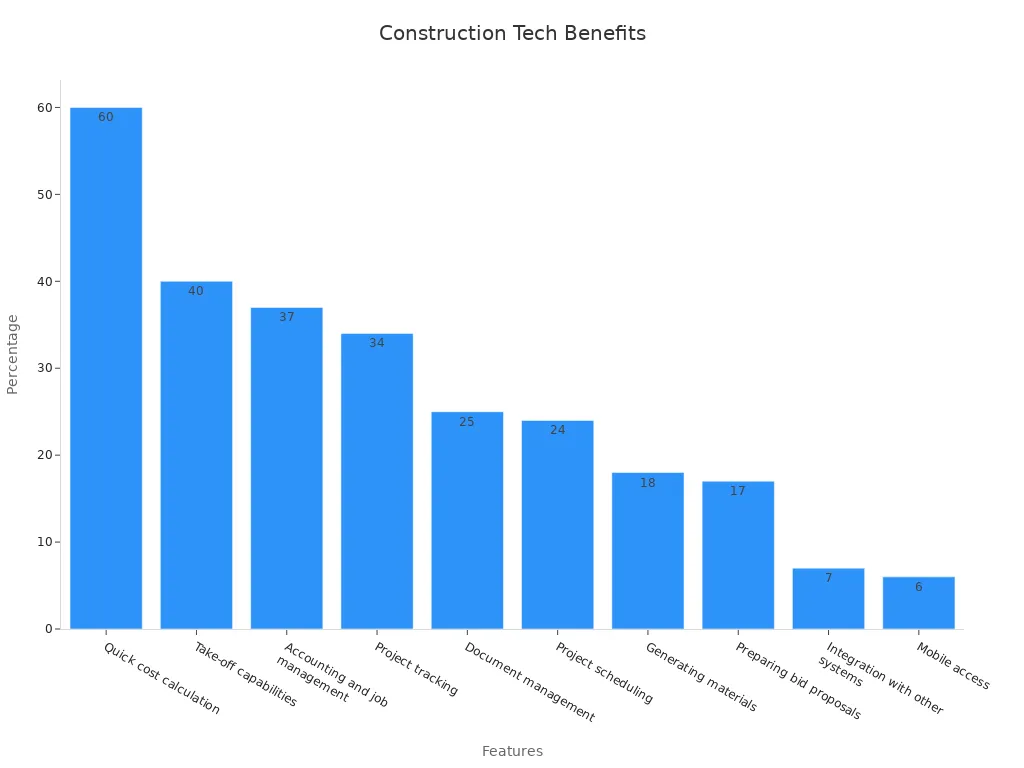
모바일 도구와 실시간 커뮤니케이션은 팀워크를 더 빠르게 만듭니다. 이러한 도구는 팀이 어디서나 대화하고 공유 할 수 있도록합니다.. 로봇 공학 및 3D 프린팅도 비용을 절감하고 작업 속도를 높이고 건축을 변화시키고 있습니다..
기술을 사용하면 프로젝트가 더 안전 해집니다, 저렴합니다, 그리고 더 빨리. 이러한 도구에 투자하면 회사가 빠르게 변화하는 업계에서 앞서 나가는 데 도움이됩니다..
장비와 새로운 아이디어로 작업을 더 쉽게 만듭니다
건설 장비 관리
기계를 양호한 상태로 유지하는 것은 매우 중요합니다. 정기적 인 점검은 문제를 중단하고 기계를 잘 작동시킵니다. 유지 보수를 건너 뛰는 경우, 지연과 사고를 유발할 수 있습니다. 장비를 자주 확인함으로써, 작은 문제를 일찍 해결할 수 있습니다.
OSHA 장비 문제로 인해 많은 부상이 발생한다고 말합니다. 정기적 인 치료는 이러한 위험을 많이 줄일 수 있습니다. 연구가 보여줍니다 70% 적절한 점검으로 기계 사고를 피할 수 있습니다. 또한, 파손 된 기계는 계획된 유지 보수보다 고치는 데 9 배 더 많은 비용이 들었습니다..
장비를 돌보는 것은 돈을 절약하고 근로자를 안전하게 유지합니다..
새로운 도구와 기계 구매
새로운 도구와 기계는 건설 작업을 개선 할 수 있습니다. 그들은 당신이 더 빨리 일하는 데 도움이됩니다, 더 안전합니다, 더 정확하게. 오래된 기계는 더 많이 깨고 오늘날의 작업을 처리하지 못할 수 있습니다.. 새로운 것을 업그레이드하면 미래를 유지하는 데 도움이됩니다.
새로운 도구가 도움이되는 방법은 다음과 같습니다:
- 그들은 더 잘 작동하고 더 오래 지속됩니다.
- 그들은 덜 자주 분해됩니다.
- 그들은 시간과 비용을 절약합니다.
- 그들은 고치고 유지하기가 더 쉽습니다.
새로운 도구를 구매하는 데 처음에는 더 많은 비용이 듭니다, 그러나 그들은 나중에 돈을 절약합니다. 작업을 더 빨리 완료하고 리소스를 더 잘 사용할 수 있습니다.
작업장의 커뮤니케이션 개선
좋은 의사 소통은 프로젝트를 잘 마무리하는 데 중요합니다. 명확한 메시지는 모든 사람이 자신의 직업을 아는 데 도움이됩니다. 나쁜 의사 소통은 실수를 유발할 수 있습니다, 지연, 그리고 사고.
의사 소통이 좋은 회사는 근로자를 더 길게 유지하고 일자리를 더 빨리 마무리합니다.. 또한 지연이 적고 더 행복한 고객이 있습니다. 잘 말하는 팀은 더 나은 결과를 얻고 문제를 피하십시오.
앱이나 소프트웨어와 같은 도구를 사용하여 업데이트를 빠르게 공유합니다.. 이 도구는 팀이 작업을 추적하고 문제를 빠르게 해결하는 데 도움이됩니다.. 열린 의사 소통을 장려함으로써, 팀워크를 개선하고 프로젝트를 순조롭게 완료 할 수 있습니다.
팀워크를 장려하고 아이디어를 공유합니다
팀워크 및 아이디어 공유 아이디어는 더 나은 건설 작업에 중요합니다.. 팀이 함께 일할 때, 프로젝트는 더 빨리 진행되고 더 나아졌습니다. 열린 커뮤니케이션과 아이디어를 공유 할 수있는 기회는 팀의 수행 방식을 바꿀 수 있습니다..
감독자와 근로자가 명확하게 대화하도록 시작하십시오. 일을 잘 듣고 설명하는 감독자는 팀 정신을 향상시킬 수 있습니다.. 노동자들은 자신의 아이디어가 들리면 더 행복하다고 느낍니다. 이것은 그들이 더 열심히 일하고 일자리를 더 즐기게합니다.. 좋은 리더는 팀이 집중력을 유지하고 더 똑똑하게 일할 수 있습니다..
팀이 쉽게 협력 할 수 있도록 작업을 더 간단하게 만듭니다. 서류를 줄이고 간단한 도구를 사용하면 시간을 절약 할 수 있습니다.. 예를 들어, 업데이트 또는 작업 목록을위한 앱은 모든 사람을 추적합니다.. 이 도구는 또한 팀이 프로젝트에서 무슨 일이 일어나고 있는지 알 수 있도록 도와줍니다..
피드백을위한 공간을 만들어 노동자들이 아이디어를 공유하게합니다.. 정기적 인 체크인은 근로자가 개선 할 수있는 곳을 보여줄 수 있습니다. 정직한 리뷰는 신뢰를 구축하고 직원에게 중요한 것을 보여줍니다. 또한 직원들이 경력을 계획하거나 새로운 기술을 배우도록 도와 주면서 직원을 지원할 수 있습니다.. 지지를 느끼는 근로자는 아이디어를 공유하고 더 잘 일할 것입니다..
더 강력한 팀 채권을 구축하기 위해 재미있는 활동을하십시오. 승리를 축하하거나“좋은 직업”을 말하는 것은 노동자들이 감사하게 생각할 수 있습니다.. 근로자가 가치가 있다고 느낄 때, 그들은 함께 더 잘 일하고 그들의 직업에 대해 더 관심을 갖습니다..
의사 소통을 개선하여, 작업을 더 쉽게 만듭니다, 그리고 피드백을 장려합니다, 더 강력한 팀을 구축 할 수 있습니다. 이 단계는 프로젝트를 개선 할뿐만 아니라 더 행복한 직장을 만듭니다..
지속 가능성 및 환경 고려 사항
재활용 및 친환경 재료 사용
재활용 재료를 사용하면 환경과 프로젝트가 도움이됩니다. 이 재료는 폐기물을 자르고 자원을 절약합니다, 일을 더 친환경적으로 만듭니다. 예로는 재활용 강철이 있습니다, 재생 된 나무, 그리고 친환경 콘크리트. 그들은 현장에서 위험을 줄이면서 품질을 높게 유지합니다.
녹색 재료의 필요성이 빠르게 증가하고 있습니다. ~ 안에 2023, 시장은 가치가 있습니다 $225.9 10억. 에 의해 2031, 도달 할 수 있습니다 $539.2 10억, 성장 11.8% 매년. 녹색 인증 및 정부 보상은 이러한 자료를 사용하여 더 똑똑하게 만듭니다..
재활용 재료를 추가하면 부지가 더 안전하고 지구를 도와줍니다..
에너지 효율적인 장비 및 관행
에너지 절약 도구는 비용을 낮추고 안전을 향상시킵니다. 새로운 기계는 에너지가 적지 만 더 잘 작동합니다. 예를 들어, 태양열 도구 및 LED 조명 돈을 절약하고 오염을 줄입니다.
다음은 실제 예입니다:
| 사례 연구 | 에너지 절약 | 돈을 절약했습니다 |
|---|---|---|
| 병원은 배출량을 줄입니다 104 매년 톤 | N/A | $84,000 |
| 중서부 병원은 보일러 테스트 시간을 줄입니다 80% | N/A | $10,940 |
이들은 에너지 절약 도구가 돈을 절약하고 안전을 돕는 방법을 보여줍니다.. 그것들을 사용하면 사이트와 환경에 좋습니다..
건설 현장을위한 폐기물 관리 시스템
좋은 폐기물 시스템은 작업을 더 안전하고 빠르게 만듭니다. 각 프로젝트에 대한 폐기물 계획으로 시작하십시오. 이 계획은 폐기물과이를 줄이는 방법을 찾습니다. 재활용 및 재사용 재료 자료 컷 쓰레기가 매립지로 보낸 쓰레기.
BIM과 같은 기술은 재료를 더 잘 계획하는 데 도움이됩니다, 절단 폐기물. IoT 도구는 실시간으로 폐기물을 추적합니다. AI 분류 시스템 재활용을위한 쓰레기 별도.
노동자들이 폐기물을 올바르게 발견하고 정렬하도록 훈련시킵니다. 그들에게 재활용하고 쓰레기를 줄 이도록 가르치십시오. 훈련은 녹색의 사고 방식과 안전한 업무 습관을 구축합니다. 이 단계는 귀하의 사이트를 깨끗하게 만듭니다, 더 안전합니다, 더 친환경적입니다.
녹색 공급 업체와 파트너 관계
녹색 교통 안전 제품과 함께 공급 업체는 건축 방식을 변경할 수 있습니다.. 이러한 파트너십은 환경에 해를 끼칩니다, 돈을 절약하십시오, 공정한 관행을 지원합니다. 지구를 신경 쓰는 교통 안전 제품 공급 업체는 회사와 지구를 도와줍니다..
녹색 교통 안전 제품 공급 업체는 자연에 더 나은 재료를 사용합니다.. 그들은 재생 가능한 자원을 재활용하고 사용합니다, 폐기물과 오염이 적습니다. 예를 들어, 재활용 강철 또는 오래된 목재를 사용하면 프로젝트가 원인으로 인한 피해를 줄입니다.. 이 자료는 강력하고 친환경 건물의 필요성을 충족합니다..
이러한 교통 안전 제품 공급 업체는 또한 돈을 절약 할 수 있도록 도와줍니다.. 녹색 방법은 폐기물을 줄이고 자원을 더 잘 관리합니다. 예를 들어, 똑똑하게 품목을 포장하거나 효율적으로 배송하는 공급 업체는 비용을 절감 할 수 있습니다.. 이것은 당신이 다른 프로젝트 요구에 현명하게 돈을 쓸 수있게 해줍니다..
녹색 교통 안전 제품 공급 업체는 또한 사람들을 신경 씁니다. 그들은 노동자들을 공정하게 대하고 지역이 성장하는 데 도움이됩니다. 그들과 함께 일함으로써, 당신은 당신이 옳은 일을하는 것에 관심을 보여줍니다. 이것은 고객과의 신뢰를 구축하고 회사를 좋아 보이게합니다..
다음은 녹색 공급 업체가 훌륭한 이유에 대한 간단한 테이블입니다.:
| 혜택 유형 | 그것이하는 일 |
|---|---|
| 환경을 돕습니다 | 폐기물을 삭감합니다, 오염을 낮 춥니 다, 재생 가능한 재료를 사용합니다. |
| 돈을 절약합니다 | 낭비하고 자원을 잘 관리하여 비용을 줄입니다. |
| 사람들을 지원합니다 | 공정한 대우를 보장하고 지역 사회를 돕습니다. |
녹색 교통 안전 제품 공급 업체 선택은 프로젝트에 좋습니다., 행성, 그리고 사람들. 이 선택은 책임감있게 건설에 관심을 보인다. 현명하게 행동함으로써, 당신은 더 녹색 미래로가는 길을 이끌 수 있습니다.
규칙 및 허가 준수
안전에 대한 OSHA 규칙에 따릅니다
OSHA 규칙 근로자를 안전하게 유지하는 데 중요합니다. 이 규칙은 근로자를 위험으로부터 보호하고 작업장을 더 안전하게 만듭니다.. OSHA 규칙을 자주 확인하여 변경 사항을 업데이트하십시오. 정기적으로 사이트를 정기적으로 검사하여 위험을 빠르게 찾고 수정하십시오.. 예를 들어, 사다리를 확인하십시오, 발판, 기계는 OSHA 규칙을 충족합니다. 이것은 사고를 예방하고 안전에 관심이 있음을 보여줍니다..
교육은 OSHA 규칙을 따르는 데 매우 중요합니다. 직원들에게 안전을 유지하고 도구를 올바르게 사용하는 방법을 가르치십시오.. 근로자들에게 이러한 단계를 상기시키기 위해 종종 안전 훈련을 연습합니다.. OSHA 규칙에 따라, 당신은 사이트를 더 안전하게 만들고 큰 벌금을 피합니다.
건축 및 도로 작업에 대한 허가를 확인합니다
모든 건설 프로젝트에는 허가가 필요합니다. 그들은 당신의 작업이 지역 및 국가 법을 따릅니다.. 시작하기 전에, 필요한 모든 허가가 있는지 확인하십시오. 여기에는 건축 허가가 포함됩니다, 도로 작업, 및 환경 규칙.
체크리스트를 사용하여 허가를 추적하십시오. 허가 수표 및 갱신을 처리하기 위해 팀의 누군가를 선택하십시오.. 이것은 프로젝트 중에 만료되는 것이 허가를 중지합니다. 체계적인 상태는 지연을 피하고 일정에 따라 작업을 계속합니다. 허가 관리는 또한 고객 및 검사관과의 신뢰를 구축합니다..
안전 징후를 최신 상태로 유지합니다
안전 표시는 건설 현장에서 매우 중요합니다. 명확한 표시는 근로자와 방문객이 혼란과 사고를 피하는 데 도움이됩니다.. 현재 규칙에 따라 표시를 확인하십시오.. 구식 또는 손상된 표지판을 즉시 교체하십시오.
안전 보드도 도움이됩니다. 그들은 중요한 안전 팁을 보여줍니다, 비상 단계와 위험 경고처럼. 조직화 된 보드는 규칙을 쉽게 따르고 검사를 통과 할 수 있습니다.. 아래 표는 업데이트 된 안전 부호가 중요한 이유를 보여줍니다.:
| 증거 설명 | 핵심 요점 |
|---|---|
| 분명한, 조직 된 정보 | 노동자들은 안전 규칙을 더 잘 따릅니다, 매일 알림. |
| 안전 약속을 보여줍니다 | 안전 정보가있는 보드는 규칙을 충족하고 검사를 향상시킵니다. |
| 더 쉽게 준수합니다 | 조직화 된 보드는 건강 및 안전 규칙을 충족하는 데 도움이됩니다. |
| 더 나은 검사 | 업데이트 된 보드는 안전 초점을 보여줍니다, 규칙 위반이 줄어 듭니다. |
| 위험을 관리하는 데 도움이됩니다 | 정기적 인 업데이트는 근로자를 인식하고 안전 규칙을 따릅니다. |
안전 징후 업데이트는 안전성을 향상시키고 규칙을 충족시킵니다. 이 간단한 단계는 사이트를 안전하게 유지하고 원활하게 실행하는 데 도움이됩니다..
팀에 대한 규정 준수 규칙을 설명합니다
규정 준수 규칙을 공유하면 팀이 안전법을 준수하는 데 도움이됩니다.. 혼란은 사고를 유발할 수 있습니다, 지연, 또는 벌금. 간단한 전략을 사용하면 모든 사람들에게 정보를 제공하고 안전하게 작업 할 수 있습니다.
규정 준수를 관리 할 계획을 세우십시오. 이 계획은 작업을 나열해야합니다, 규칙, 그리고 누가 무엇을하는지. 확인 허가와 같은 작업을 할당하십시오, 기록 유지, 그리고 안전 점검을 수행합니다. 모두가 자신의 직업을 알고있을 때, 준수하는 것이 더 쉬워집니다.
점검표를 사용하여 물건을 간단하게 만듭니다. 예를 들어, 뉴욕의 한 회사는 체크리스트를 사용하여 키가 큰 건축 프로젝트에서 규칙을 따릅니다.. 그들은 또한 소음 장벽을 추가하고 안전 훈련을 실천했습니다. 이 단계는 검사 준비를 유지하고 문제를 피하는 데 도움이되었습니다..
기술도 도움이 될 수 있습니다. Grycon이라는 회사는 AI 도구를 사용하여 문서를 스캔했습니다.. 이 도구는 실수를 줄이고 시간을 절약했습니다. 유사한 도구를 사용하여 논문을 구성하고 작업을 더 잘 추적 할 수 있습니다..
훈련은 매우 중요합니다. 팀에게 규칙을 가르치십시오, 그들에게 그들을 따르는 방법을 보여주십시오, 그리고 질문에 답하십시오. 안전 훈련, 뉴욕의 사람들처럼, 근로자가 비상 사태를 준비하도록 도와줍니다.
팁: 안전 정보를 쉽게 찾을 수 있습니다. 게시 규칙, 비상 단계, 보드 또는 앱에서 세부 정보를 허용합니다. 이런 식으로, 근로자는 알아야 할 사항을 빨리 확인할 수 있습니다.
명확한 계획을 사용하여, 유용한 도구, 그리고 정기 훈련, 안전하고 규칙을 따르는 직장을 만들 수 있습니다. 이 접근법은 팀과 검사관 모두에게 위험을 낮추고 신뢰를 구축합니다..
4 월은 건설 작업에 대한 특별한 도전을 가져 오지만 개선 기회도 제공합니다.. 미리 계획함으로써, 직원을 안전하게 유지하고 제 시간에 프로젝트를 마칠 수 있습니다..
FAQ
건설 현장에서 봄 날씨를 어떻게 준비 할 수 있습니까??
매일 날씨를 확인하고 그 주변의 작업을 계획하십시오.. 노동자들에게 레인 코트를 준다, 방수 부츠, 그리고 다른 날씨 장비. 물로 손상되지 않는 재료를 사용하십시오. 물이 수집되는 것을 막기 위해 배수구를 추가하십시오. 이 단계는 변화하는 날씨를 더 잘 처리하는 데 도움이됩니다.
보행자를 건설 구역 근처에서 안전하게 유지하려면 어떻게해야합니까??
사람들을 직장에서 멀리 떨어 뜨리기 위해 장벽을 세우십시오.. 밝게 사용하십시오, 안전한 경로를 보여주는 명확한 표지판. 장벽과 표지판을 자주 확인하여 작동하는지 확인하십시오.. 덮은 보도는 또한 사람들이 떨어지는 물체로부터 보호 할 수 있습니다, 사이트 근처에 안전하게 유지하십시오.
장비를 관리하는 것이 중요한 이유는 무엇입니까??
기계를 돌보는 데있어서 사고를 당하고 사고를 일으키지 않습니다.. 안전하고 제대로 작동하게합니다. OSHA는 말한다 70% 좋은 관리로 기계 부상을 피할 수 있습니다. 기계를 정기적으로 고정함으로써, 당신은 돈을 저축하고 노동자를 보호합니다.
친환경 재료를 사용하는 데있어 좋은 점은 무엇입니까??
친환경 재료는 폐기물을 자르고 환경을 돕습니다. 또한 유해한 배출량을 낮추어 사이트를 더 안전하게 만듭니다. 재활용 강철 또는 오래된 나무를 사용하면 돈을 절약하고 녹색 목표를 충족시킵니다.. 이 자료는 안전하게 구축하고 친환경 고객을 유치 할 수 있습니다..
기술이 건설 프로젝트를 관리하는 데 어떻게 도움이됩니까??
기술은 계획과 팀워크를 더 쉽게 만듭니다. BIM과 같은 도구는 문제를 일찍 해결하기위한 3D 디자인을 보여줍니다.. 프로젝트 소프트웨어는 작업 및 리소스를 추적합니다. 모바일 앱은 업데이트를 빠르게 제공합니다, 그래서 팀은 정보를 유지합니다. 이 도구는 시간을 절약하고 실수를 줄입니다.

